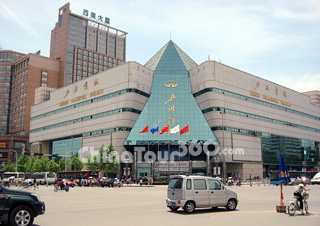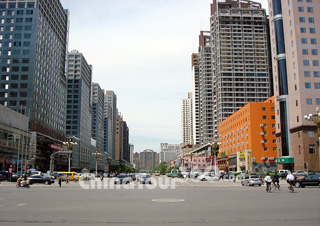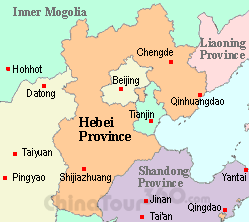 Shijiazhuang City
Shijiazhuang City Street Scene
Street Scene Zhaozhou Bridge of the Sui Dynasty
Zhaozhou Bridge of the Sui Dynasty
![]() Facts:
Facts:
Phone Code: 0311
Postal Code: 050000
Area: 15,848 square kilometers (6,117 square miles)
Population: 10.16 million (statistics in 2010)
Nationalities: Han, Hui
Neighboring Areas: Shanxi, Inner Mongolia, Liaoning, Shandong and Henan Province; Beijing and Tianjin Municipality
Location: Shijiazhuang is located in the south-central Hebei Province. The latitude is between 37°27′-38°47′N, and the longitude is between 113°30′-115°20′E.
![]() Physical Features: Shijiazhuang neighbors Beijing and Tianjin in the west. Since the city extends across both the Taihang Mountains and the north China plain, its land slopes down from the west to the Bohai Sea in the east with complex landforms. The altitude of the mountainous area is about 1,000 meters (3,280 feet), but that of most of the urban city is less than 100 meters (328 feet). There are numerous rivers, such as Hutuo River, Xiaohe River, Jinhe River and Huaihe River.
Physical Features: Shijiazhuang neighbors Beijing and Tianjin in the west. Since the city extends across both the Taihang Mountains and the north China plain, its land slopes down from the west to the Bohai Sea in the east with complex landforms. The altitude of the mountainous area is about 1,000 meters (3,280 feet), but that of most of the urban city is less than 100 meters (328 feet). There are numerous rivers, such as Hutuo River, Xiaohe River, Jinhe River and Huaihe River.
![]() Attractions: Relying on a beautiful landscape and long history, the city enjoys numerous tourist resources, including 18 national protection sites and 98 province-level cultural relic protection units. Among them, the Zhaozhou Bridge, built in the Sui Dynasty, ranks as number one. It greatly contributes to the science of bridge building techniques. Other highly recommended tourist destinations in the city and the surrounding area are Longxing Temple in Zhengding County, Mt. Cangyan Scenic Area, Xibaipo Mountain Village, Mt.Tiangui, which is regarded as Guilin of North China, and Wuyue Village Scenic Area in Lingshou County. In addition, for cultural entertainment tourists can enjoy folk performances during the Chinese Lantern Festival there in winter, and listen to Hebei Bangzi, which combines the folkways and rhythms of Beijing, Tianjin and Hebei.
Attractions: Relying on a beautiful landscape and long history, the city enjoys numerous tourist resources, including 18 national protection sites and 98 province-level cultural relic protection units. Among them, the Zhaozhou Bridge, built in the Sui Dynasty, ranks as number one. It greatly contributes to the science of bridge building techniques. Other highly recommended tourist destinations in the city and the surrounding area are Longxing Temple in Zhengding County, Mt. Cangyan Scenic Area, Xibaipo Mountain Village, Mt.Tiangui, which is regarded as Guilin of North China, and Wuyue Village Scenic Area in Lingshou County. In addition, for cultural entertainment tourists can enjoy folk performances during the Chinese Lantern Festival there in winter, and listen to Hebei Bangzi, which combines the folkways and rhythms of Beijing, Tianjin and Hebei.
![]() Transportation:
Transportation:
![]() Air: Zhengding Airport is located 32 km (19.9 miles) northeast of Shijazhuang City. It operates flights to 24 major domestic cities, such as Shanghai, Guangzhou, Xian, Chengdu and Shenzhen. It is also easy to reach Beijing Capital International Airport and Tianjin Airport by shuttle bus. Consequently, Zhengding Airport was a major alternative airport during the Olympic Games in 2008.
Air: Zhengding Airport is located 32 km (19.9 miles) northeast of Shijazhuang City. It operates flights to 24 major domestic cities, such as Shanghai, Guangzhou, Xian, Chengdu and Shenzhen. It is also easy to reach Beijing Capital International Airport and Tianjin Airport by shuttle bus. Consequently, Zhengding Airport was a major alternative airport during the Olympic Games in 2008.
![]() Train: From Shijiazhuang Railway Station there are trains running between Beijing and Guangzhou, from Shijiazhuang to Taiyuan and Dezhou. The train from Shuozhou to Huanghuagang passes through the city to the north. It is connected by rail with more than 50 cities in China, such as Lhasa, Kunming, Guilin and Shanghai.
Train: From Shijiazhuang Railway Station there are trains running between Beijing and Guangzhou, from Shijiazhuang to Taiyuan and Dezhou. The train from Shuozhou to Huanghuagang passes through the city to the north. It is connected by rail with more than 50 cities in China, such as Lhasa, Kunming, Guilin and Shanghai.
![]() Subway: A total of 6 subway lines are planned to be built in the city. Subway line 1 and line 2 are now under construction.
Subway: A total of 6 subway lines are planned to be built in the city. Subway line 1 and line 2 are now under construction.
![]() Bus: Long-distance bus transportation is very convenient in the city, since over ten stations are scattered through the city. City buses, as well as the tourism lines 1, 5, 6, and 7, go to nearby scenic spots.
Bus: Long-distance bus transportation is very convenient in the city, since over ten stations are scattered through the city. City buses, as well as the tourism lines 1, 5, 6, and 7, go to nearby scenic spots.
![]() Taxi: The minimum fare is RMB 5, and RMB 1.6 per km exceeding the first 2 km (1.2 miles).
Taxi: The minimum fare is RMB 5, and RMB 1.6 per km exceeding the first 2 km (1.2 miles).
![]() Weather: Located in the temperate zone, Shijiazhuang has a sub-humid continental monsoon climate featuring four distinct seasons. Rain falls mainly in summer and early autumn. September and October are the most comfortable months to visit Shijiazhuang.
Weather: Located in the temperate zone, Shijiazhuang has a sub-humid continental monsoon climate featuring four distinct seasons. Rain falls mainly in summer and early autumn. September and October are the most comfortable months to visit Shijiazhuang.
![]() Dining and Shopping:
Dining and Shopping:
Hebei Cuisine is the most recommended cuisine in Shijiazhuang. Many traditional dishes are named after Chinese mythology, which both highlights the food and adds cultural flavor. The recommended food to taste includes Huimin Baji (wrapped Braised Chicken of the Hui people) and Gaocheng Gongmian (Gaocheng Royal Noodles). Local snacks like Ganglu Shaobing (Clay Oven Roll), Guanghua Rou Ge (Guanghua boneless pigeon) and Lv Rou Huo Shao (Baked Wheat Cake Stuffed with Minced Donkey Meat) are also highly recommended.
Local products include the Chinese toon plant, Snowflake pear, Xingtang Chinese date, Longxing royal rice, Pingshan walnut, and Great Wall White Wine. The most well-known shopping streets are Zhongshan Road, Hong Qi Street and the streets around Shijiazhuang Railway Station. South Garden Pedestrian Street is the central business district in the city. There are various shopping malls, large-scale restaurants and supermarkets, as well as office towers.








